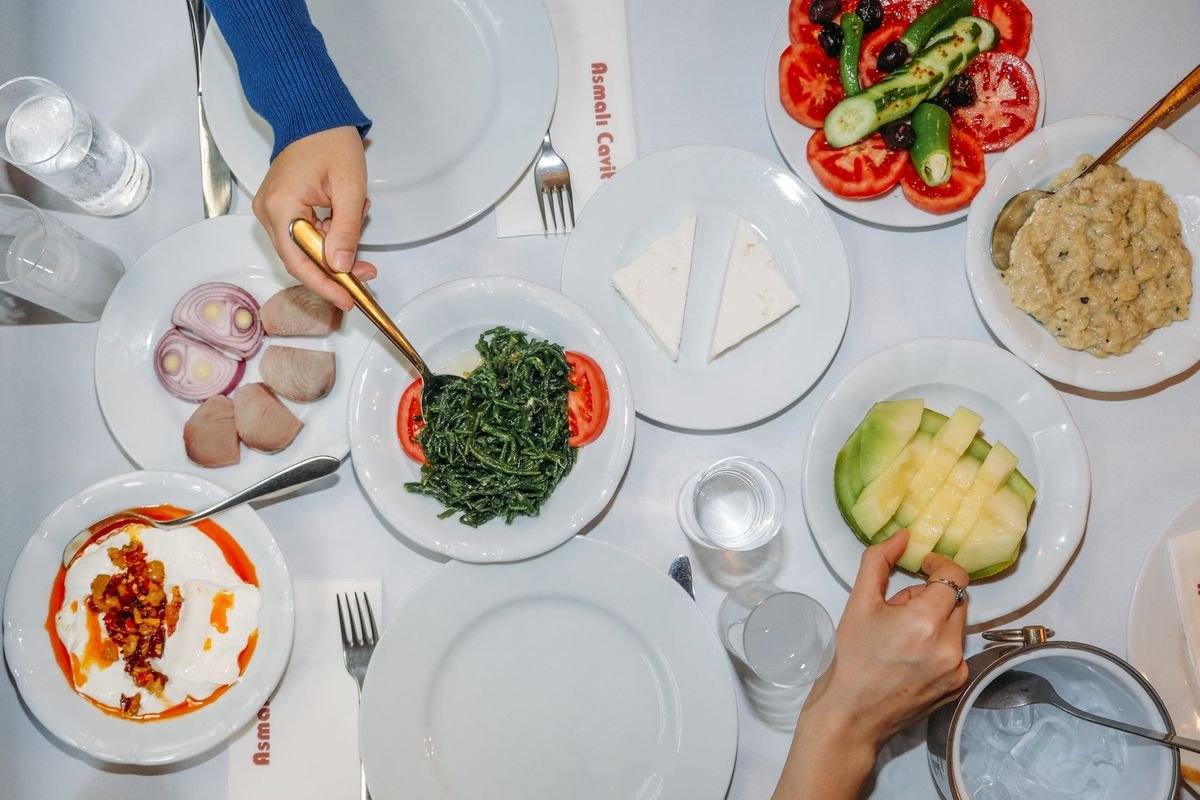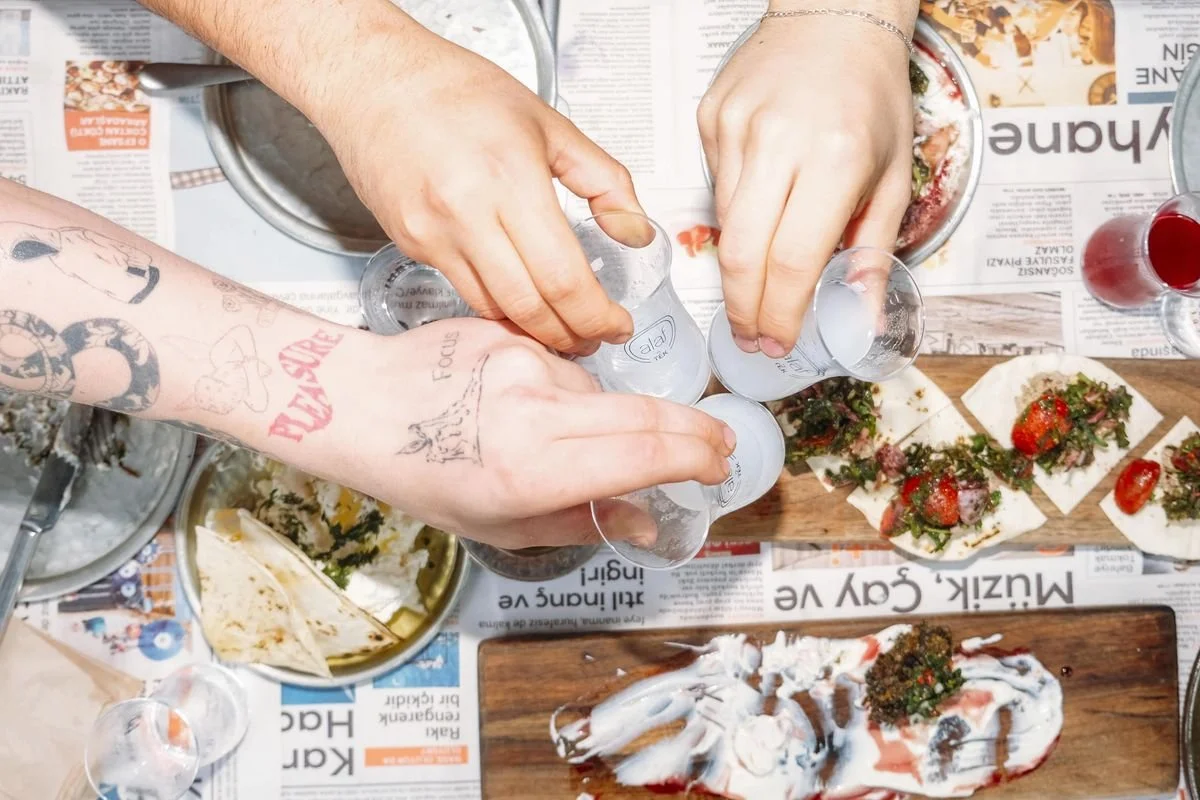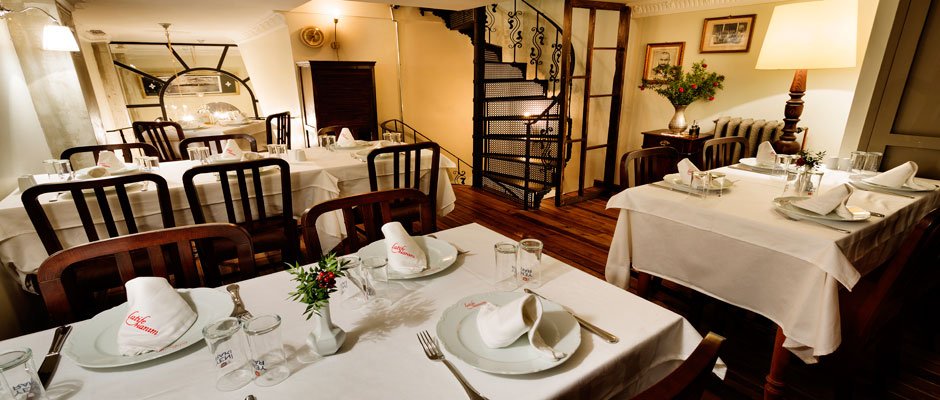Beyond the Table: Exploring It’s Layers
The most crucial element surpassing mere seating in a chair is the table itself. The table embodies sharing and gathering within its existence. It can appear in any form or material. The rakı table (rakı sofrası), with its mezes, cover, plates, cutlery, and people, transforms into a gathering spot. The table is the curator of the entire meyhane setup. It curates the selection of mezes, shapes the conversation, and extends the meyhane as a space beyond the physical boundaries. Meyhanes, characterised by their rituals around the table and the presence of rakı, can emerge in any location. What remains constant is their intrinsic connection to the table, where rituals and culture finds its expression. This table, holds a particular significance—the "sofra". The very essence of meyhane culture crystallises around this shared space of dining and imbibing, an embodiment of togetherness and collectiveness.
Alaf2Tek , source: alaf2tek instagram account
The emergence of what we now recognize as the meyhane began to manifest itself in the second half of the 19th century. Upon entering, regulars were greeted by a counter, adorned with glasses of rakı and wine, accompanied by small plates of mezes and nuts. Here, it's essential to distinguish between the concepts of a table and a sofra. During the era of Gedikli Meyhanes, customers would gather not around a table but around çilingir sofraları, cheap, round tables made of wood, where mezes were also served on round trays. By the late 19th century, tables had replaced sofras, but the tradition of the sofra and sofracılık (the art of laying the sofra) was still upheld in meyhanes.
From Çilingir Sofrası to Western Style Tables
By the time of the Republic, the modernization movements reflected in society also influenced meyhanes. The most significant change in meyhanes, which underwent structural changes parallel to society, occurred within the space. The centuries-old sini-stool-sofra arrangement in Gedikli meyhanes gave way to the Western-style table-chair arrangement. Similarly, the salt bowl, symbolizing abundance and luck in meyhane tables, was replaced by salt shakers, alongside which pepper shakers were added. White tablecloths began to be laid out on tables, and with the production of porcelain and ceramic factories, wooden and copper plates were replaced by porcelain plates.
Illustrated by Duru Bebekoğlu
Exploring the Components: Cover, Plates, Cutlery, Conversations, Mezes, and Glasses
With efforts to preserve the tradition of the sofra (çilingir sofrası), the porcelain plates -for every individual at the table- remained empty. Round meze plates, salad bowls, and small dishes began to change the presentation of plates in collaboration with the table. Wooden spoons were replaced by metal cutlery, and cutlery became a constant feature on the table. By predominantly using white on the tables, a stronger association with rakı white was established. Alongside the new table layouts, transparent materials also came to the forefront, resulting in the creation of glass and crystal special glasses for rakı.
Açık Hava Meyhanesi, London, Pop-up Meyhane by Istanbul Elsewhere, photo by Ferhat Elik
In addition to white-clothed tables, there were also marble tables used by 'tektekçilers'—those who don't spend extended periods of time in meyhanes but rather drink one glass and then leave—easily wiped clean.
Tophane’de Koltuk Meyhanesinde İki Adam, Ara Güler, 1959
To maintain consistency with white tablecloths, marble was also used in white. The majority of meyhanes in the Republican period fell between these marble and white-clothed tables, and to deal with the stains of appetizers, they started covering wooden tables with white linoleum or transparent linoleum on top of white cloths.
Güneşin Sofrası
With the legal regulations of the 1950s, a class system was introduced to establishments serving alcohol and restaurants. Thus, establishments and customers began to be separated by distinct class differences. Since meyhanes were mostly located in second or third-class establishments, service was restructured. The quality of porcelain used on tables, whether it was imported or not, became more apparent in these different classes of meyhanes. With the increasing use of refrigerators during this period, ice was also added to rakı, fundamentally changing the rakı service on the table. Highball glasses, used as lemonade glasses instead of traditional rakı glasses, began to be used because they could be chilled with ice.
Soul of Çilingir Sofrası
Although entering the category of establishments serving alcohol with this law, there is still a significant difference among them. Meyhanes, while moving forward with the tradition of the çilingir sofrası, continued with specific rules/rhythms. The sofra (now taking the form and furniture beyond just a table) is there not for eating but for conversing accompanied by rakı. There is no personalized service (hence the mentioned porcelain plates remain empty), and the mezes brought are meant to be shared with everyone at the table. These mezes are prepared in a way that could easily be picked up with a spoon, allowing the table to facilitate a unifying activity.
Asmalı Cavit, Photo by Deniz Sabuncu , source: Aposto
Photo: Deniz Sabuncu , source: Aposto
The display of mezes on the sofra is to create harmony and placed in a suitable order. As the foundation of the meyhane and sofra concept, the table is the most living and life-giving part of the meyhane. Mezes, especially when arranged on white tablecloths, are highlighted, attempting to make the table the focal point.
The table of the meyhane is also used as a means of communication. Communication with the service was and still is one of the most important factors attracting regulars to the meyhane. In the old Istanbul meyhanes, skillful and quick waiters established communication through the tables, leaving a lasting impression in memory, as Cahit Sıtkı mentions in his stories. The relationship between the customer, waiter, and the meyhane, established through the customer's movements in their chair, stirring their fork in the meze plate, waiter taking away empty plates and glasses from the table, garnishing the table with mezes, and filling glasses, highlights how service in meyhane is understood through the table.
Latife Hanım Meyhanesi
Architectural Considerations: Thinking of Tables for Current Meyhane Experiences
Today, besides the production of tables from wood and marble materials, the positioning and arrangement of tables in meyhanes should continue to be considered for both service and the experience of the seated individuals. Does the table extend to public space? How should circulation and experience be considered in tables on the street and sidewalk? Are there both open and closed seating areas? Can semi-open spaces be created with overhead coverings? If a winter garden is being made, it can serve as both an indoor and semi-open space. Since it is associated with indoor seating areas, circulation solutions can be more easily solved within the space.
Leb-i Derya, source: meyhanedeyiz.biz
It is important to accommodate large crowds in the planning organization but also to create spaces that allow for privacy. The customer base is an important target in these matters. Tables can be easily moved to accommodate large groups, or they can be designed as a regulars' meyhane to accommodate a small number of people. In meyhanes targeting small groups, lighting at each table can make the atmosphere more intimate. In venues hosting large groups, general lighting facilitates table usage. Regardless of the number of groups, the most important point of the meyhane is the essential feature of the sofra. Although having a tablecloth highlights the appetizers, if the use of tablecloths is not preferred, material selection should lean towards durable, stain-resistant, and easy-to-clean materials.Meyhanes are social spaces, times spent with rakı and mezes around conversations. Thus, the distance between tables should be as much as the distance for clinking glasses.
Flexible planning of tables that can be adjusted according to the density of the meyhane can also relieve space organization. While small tables are formed during the day, evolving into a table-space organization tailored to needs as the venue becomes crowded towards the evening can be better.
Güneşin Sofrası
Environmental psychology is also a critical factor in shaping spatial organization within the meyhane. The selection of tables is tailored to the size of the venue, with careful consideration given to regulars’ psychological comfort. Typically, when the venue is empty, tables near the walls are preferred, as they provide a sense of security. The compatibility of the chosen furniture with the space further enhances this feeling of safety, fostering a relaxed atmosphere conducive to engaging conversations.
Gathering around beyond the table
In every scenario and scene unfolding within meyhane walls, tables emerge as the dominant and foundational elements. It is through these tables that the meyhane transforms into a space, perpetuating the rituals and rhythms enacted around them. Every spatial element within the meyhane, from the walls to the lighting, chairs, and meze displays, finds its place in harmony with the arrangement of the tables. The unifying act of gathering around these tables extends the essence of the meyhane beyond its physical boundaries and into the realm of collective experience. As one enters the establishment, the table not only signifies possibilities but also signifies the relationships that transcend mere interior furnishings.
Indeed, as the pulse of the meyhane beats to the rhythm of conversations and shared moments, the significance of the table extends beyond its tangible presence. It serves as a conduit for connection, a stage for the interplay of personalities and stories. Each table tells a tale of laughter, companionship, and shared experiences, weaving together the threads of community that define the essence of the meyhane. And as we contemplate the role of the table in shaping these narratives, we are reminded of its capacity to bridge the divide between the past and present. As we embrace the spirit of the meyhane, let us honour the table not merely as furniture but as a symbol of unity and fellowship, inviting all who enter to partake in its timeless rituals.
Further Readings
Meyhane İhtisas Kitabı , Anason İşleri, 2022
Murat Can Kabagöz. Eğlenirken Modernleşmek : Meyhaneden Baloza, Imparatorluk’tan Cumhuriyet’e Istanbul. Ankara: Heretik Yayınları, 2016.










